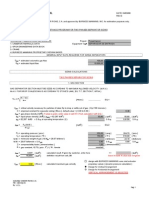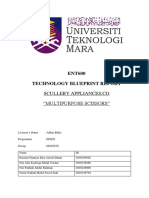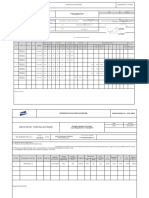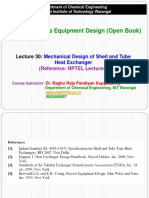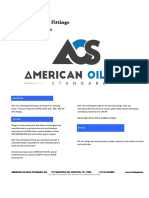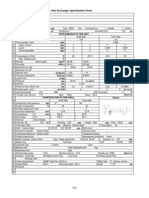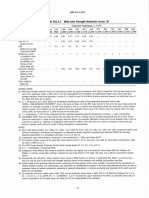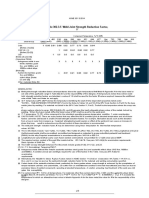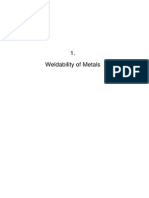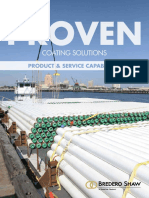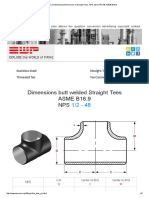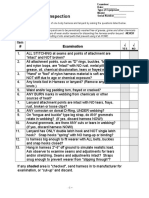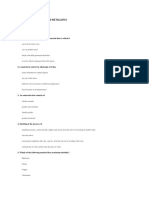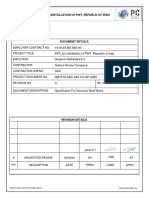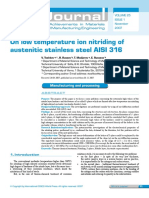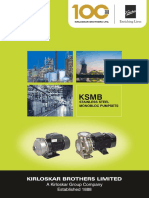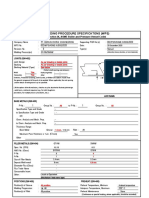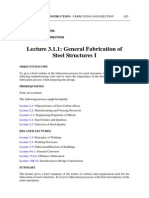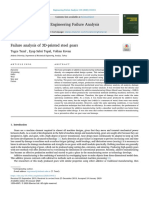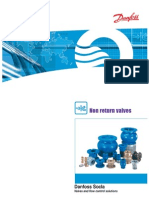ASME-B-31.3-2016-Table 302.3.5-Weld Joint Strength Reduction Factor (W)
ASME-B-31.3-2016-Table 302.3.5-Weld Joint Strength Reduction Factor (W)
Uploaded by
groshan20Copyright:
Available Formats
ASME-B-31.3-2016-Table 302.3.5-Weld Joint Strength Reduction Factor (W)
ASME-B-31.3-2016-Table 302.3.5-Weld Joint Strength Reduction Factor (W)
Uploaded by
groshan20Copyright
Available Formats
Share this document
Did you find this document useful?
Is this content inappropriate?
Copyright:
Available Formats
ASME-B-31.3-2016-Table 302.3.5-Weld Joint Strength Reduction Factor (W)
ASME-B-31.3-2016-Table 302.3.5-Weld Joint Strength Reduction Factor (W)
Uploaded by
groshan20Copyright:
Available Formats
ASME B31.
3-2016
Table 302.3.5 Weld Joint Strength Reduction Factor, W
Component Temperature, Ti, °C (°F)
427 454 482 510 538 566 593 621 649 677 704 732 760 788 816
Steel Group (800) (850) (900) (950) (1,000) (1,050) (1,100) (1,150) (1,200) (1,250) (1,300) (1,350) (1,400) (1,450) (1,500)
CrMo 1 0.95 0.91 0.86 0.82 0.77 0.73 0.68 0.64 ... ... ... ... ... ...
[Notes (1)–(3)]
CSEF (N + T) ... ... ... 1 0.95 0.91 0.86 0.82 0.77 ... ... ... ... ... ...
[Notes (3)–(5)]
CSEF ... ... 1 0.5 0.5 0.5 0.5 0.5 0.5 ... ... ... ... ... ...
[Notes (3) and (4)]
(Subcritical PWHT)
Autogenous welds in aus- ... ... ... 1 1 1 1 1 1 1 1 1 1 1 1
tenitic stainless grade
3xx, and N088xx and
N066xx nickel alloys
[Note (6)]
Austenitic stainless grade ... ... ... 1 0.95 0.91 0.86 0.82 0.77 0.73 0.68 0.64 0.59 0.55 0.5
3xx and N088xx nickel
alloys [Notes (7) and
(8)]
Other materials [Note (9)] ... ... ... ... ... ... ... ... ... ... ... ... ... ... ...
GENERAL NOTES:
(a) Weld joint strength reduction factors at temperatures above the upper temperature limit listed in Appendix A for the base metal or out-
side of the applicable range in Table 302.3.5 are the responsibility of the designer. At temperatures below those where weld joint
strength reduction factors are tabulated, a value of 1.0 shall be used for the factor W where required; however, the additional rules of
this Table and Notes do not apply.
(b) Tcr p temperature 25°C (50°F) below the temperature identifying the start of time-dependent properties listed under
"NOTES – TIME-DEPENDENT PROPERTIES" (Txx) in the Notes to Tables 1A and 1B of the BPV Code Section II, Part D for the base metals
joined by welding. For materials not listed in the BPV Code Section II, Part D, Tcr shall be the temperature where the creep rate or
stress rupture criteria in paras. 302.3.2(d)(4), (5), and (6) governs the basic allowable stress value of the metals joined by welding.
When the base metals differ, the lower value of Tcr shall be used for the weld joint.
(c) Ti p temperature, °C (°F), of the component for the coincident operating pressure–temperature condition, i, under consideration.
(d) CAUTIONARY NOTE: There are many factors that may affect the life of a welded joint at elevated temperature and all of those factors
cannot be addressed in a table of weld strength reduction factors. For example, fabrication issues such as the deviation from a true cir-
cular form in pipe (e.g., "peaking" at longitudinal weld seams) or offset at the weld joint can cause an increase in stress that may
result in reduced service life and control of these deviations is recommended.
(e) The weld joint strength reduction factor, W, may be determined using linear interpolation for intermediate temperature values.
NOTES:
(1) The Cr–Mo Steels include: 1⁄2Cr–1⁄2Mo, 1Cr–1⁄2Mo, 11⁄4Cr–1⁄2Mo–Si, 21⁄4Cr–1Mo, 3Cr–1Mo, 5Cr–1⁄2Mo, 9Cr–1Mo. Longitudinal and spiral
(helical seam) welds shall be normalized, normalized and tempered, or subjected to proper subcritical postweld heat treatment (PWHT)
for the alloy. Required examination is in accordance with para. 341.4.4 or 305.2.4.
(2) Longitudinal and spiral (helical seam) seam fusion welded construction is not permitted for C–1⁄2Mo steel above 850°F.
(3) The required carbon content of the weld filler metal shall be ≥0.05 C wt. %. See para. 341.4.4(b) for examination requirements.
Basicity index of SAW flux ≥1.0.
(4) The CSEF (Creep Strength Enhanced Ferritic) steels include grades 91, 92, 911, 122, and 23.
(5) N + T p Normalizing + Tempering PWHT.
(6) Autogenous welds without filler metal in austenitic stainless steel (grade 3xx) and austenitic nickel alloys UNS Nos. N066xx and
N088xx. A solution anneal after welding is required for use of the factors in the Table. See para. 341.4.3(b) for examination
requirements.
(7) Alternatively, the 100,000 hr Stress Rupture Factors listed in ASME Section III, Division 1, Subsection NH, Tables I-14.10 A-xx, B-xx,
and C-xx may be used as the weld joint strength reduction factor for the materials and welding consumables specified.
(8) Certain heats of the austenitic stainless steels, particularly for those grades whose creep strength is enhanced by the precipitation of
temper-resistant carbides and carbonitrides, can suffer from an embrittlement condition in the weld heat affected zone that can lead to
premature failure of welded components operating at elevated temperatures. A solution annealing heat treatment of the weld area miti-
gates this susceptibility.
(9) For carbon steel, W p 1.0 for all temperatures. For materials other than carbon steel, CrMo, CSEF, and the austenitic alloys listed in
Table 302.3.5, W shall be as follows: For Ti ≤ Tcr, W p 1.0. For Tcr < Ti ≤ 1,500°F, W p 1 − 0.000909(Ti − Tcr). If Ti exceeds the upper
temperature for which an allowable stress value is listed in Appendix A for the base metal, the value for W is the responsibility of the
designer.
You might also like
- SP-2161 Material Selection and Corrosion Control For Surface Facilities - V1Document21 pagesSP-2161 Material Selection and Corrosion Control For Surface Facilities - V1Quality IA FLOW100% (1)
- Analogi MaterialovDocument8 pagesAnalogi MaterialovrouquinNo ratings yet
- Toriconical Head Ver 1.1Document4 pagesToriconical Head Ver 1.1Iqbal AhmadsNo ratings yet
- Calculo Separador BifasicoDocument3 pagesCalculo Separador BifasicoLuisa Garcia100% (1)
- CEPE02100A1 CAG Updated Jan23 14Document60 pagesCEPE02100A1 CAG Updated Jan23 14rudi setiawanNo ratings yet
- MANUAL ASTEM A Collection of Fortran Subroutines To Evaluate 1967 ASME Equations of State PDFDocument33 pagesMANUAL ASTEM A Collection of Fortran Subroutines To Evaluate 1967 ASME Equations of State PDFTony LewisNo ratings yet
- MP Steam Boiler Package Familiarisation - Attachment 1Document12 pagesMP Steam Boiler Package Familiarisation - Attachment 1simba8661100% (2)
- DIN 536-1 - Crane Rails Hot Rolled Flat Bottom Crane Rails (Type A) Dimensions, Section Parameters and Steel GradesDocument5 pagesDIN 536-1 - Crane Rails Hot Rolled Flat Bottom Crane Rails (Type A) Dimensions, Section Parameters and Steel GradesVitor Ferreira100% (3)
- Ent600 BlueprintDocument22 pagesEnt600 BlueprintFnur Fatihah100% (1)
- BKM Reboiler Thermal DesignDocument18 pagesBKM Reboiler Thermal Design180190105084rabadiyahenilNo ratings yet
- Pressure Testing Request FormDocument1 pagePressure Testing Request FormSyed Mahmud Habibur RahmanNo ratings yet
- SQ8167 - 01 - Methanol Reboiler - BKU Option - (Alt Case 10 Deg Approach) .HTRI 6th Aug 21-CmtdDocument4 pagesSQ8167 - 01 - Methanol Reboiler - BKU Option - (Alt Case 10 Deg Approach) .HTRI 6th Aug 21-CmtdSRINo ratings yet
- Strength Calculation As Per Ibr Boiler Maker'S No.: Atpl-Rb002Document9 pagesStrength Calculation As Per Ibr Boiler Maker'S No.: Atpl-Rb002mohan babuNo ratings yet
- Heat Exchanger Data SheetDocument1 pageHeat Exchanger Data SheetomarcastillogalindoNo ratings yet
- FD Aerofoil 1590x2640Document4 pagesFD Aerofoil 1590x2640Prakash WarrierNo ratings yet
- SHORTSTOPP 300D Split Tees With Guide BarsDocument3 pagesSHORTSTOPP 300D Split Tees With Guide BarsMartin AndradeNo ratings yet
- Cross Sectional Area of WeldsDocument4 pagesCross Sectional Area of WeldsJuan RodriguezNo ratings yet
- Split-Tee ChamferingDocument10 pagesSplit-Tee ChamferingBerani JombloNo ratings yet
- Pharma Engg. Heat Transfer AreaDocument4 pagesPharma Engg. Heat Transfer AreamanojNo ratings yet
- Reactor Dimensions: Shell Thickness 10 MM (MOC SS316) Dish Thickness 12 MMDocument2 pagesReactor Dimensions: Shell Thickness 10 MM (MOC SS316) Dish Thickness 12 MMkanji63No ratings yet
- Steam Tracing AppendixDocument13 pagesSteam Tracing AppendixAmin BagheriNo ratings yet
- Mechanical Design of Shell and TubeDocument21 pagesMechanical Design of Shell and TubeMahesh ewRRpuqQrcNo ratings yet
- Equipment Data Sheet: Type: Doc No: Mds-Pv-01Document3 pagesEquipment Data Sheet: Type: Doc No: Mds-Pv-01Waqas WaqasNo ratings yet
- Contact Us Search Our Services: Click To Enable Adobe Flash PlayerDocument2 pagesContact Us Search Our Services: Click To Enable Adobe Flash Playert githenderNo ratings yet
- Split Tee CatalogoDocument3 pagesSplit Tee Catalogobotella berNo ratings yet
- Heat HXerDocument2 pagesHeat HXerGade JyNo ratings yet
- Development of AerofoilDocument6 pagesDevelopment of Aerofoilvaisakp777No ratings yet
- Calculation BS 31.3Document1 pageCalculation BS 31.3prabhjot123No ratings yet
- C300 Rim Vents: Tank AccessoriesDocument2 pagesC300 Rim Vents: Tank AccessoriesAs'adNo ratings yet
- Ferrotol No 1 Boiler CompoundDocument2 pagesFerrotol No 1 Boiler CompoundPower PowerNo ratings yet
- AES Type Heat ExchangerDocument8 pagesAES Type Heat ExchangerSudhanshu67100% (1)
- Boiler Specification 2Document3 pagesBoiler Specification 2AbdulBasitNo ratings yet
- IBR Quiz 1Document6 pagesIBR Quiz 1RAJKUMARNo ratings yet
- Agitated VesselDocument8 pagesAgitated VesselBharatShethNo ratings yet
- Spring HangerDocument2 pagesSpring HangerMamacintNo ratings yet
- 1996 - Misplon - Pinhole Grate Conversions ofDocument4 pages1996 - Misplon - Pinhole Grate Conversions ofmchoi23No ratings yet
- Asme Cal in TabularDocument14 pagesAsme Cal in TabularSundara MoorthyNo ratings yet
- IbrDocument5 pagesIbrSuresh Ram RNo ratings yet
- Pressure Vessel Design Excel Sheet Basic Designing Non Critical PDocument1 pagePressure Vessel Design Excel Sheet Basic Designing Non Critical PKaramYassNo ratings yet
- Air Cooled Heat ExchangersDocument6 pagesAir Cooled Heat Exchangersade_sofyanNo ratings yet
- Combustion Calculations For Solid and Liquid Fuels PDFDocument21 pagesCombustion Calculations For Solid and Liquid Fuels PDFHector Israel Jacinto MartinezNo ratings yet
- CPA 50E Type A RF Dimensional Specifications - May 2013Document1 pageCPA 50E Type A RF Dimensional Specifications - May 2013Karthick RamasubramanianNo ratings yet
- Sa 423Document6 pagesSa 423Widya widyaNo ratings yet
- A 1 KDocument5 pagesA 1 KSumantrra ChattopadhyayNo ratings yet
- Chapter 2 FiretubeDocument18 pagesChapter 2 FiretubeWael Abdel-MageedNo ratings yet
- Snamprogetti: CustomerDocument3 pagesSnamprogetti: Customeradesloop100% (1)
- Glaxo Vol IDocument164 pagesGlaxo Vol IPrakash WarrierNo ratings yet
- Ibr CalculationsDocument12 pagesIbr CalculationsGopal RamalingamNo ratings yet
- Asme B31.3 W ValuesDocument1 pageAsme B31.3 W Valuesjoaquin torrano veraNo ratings yet
- Asme b31.3 2014 Recognized 1Document4 pagesAsme b31.3 2014 Recognized 1Anonymous u2FhhHVpmNo ratings yet
- Examining The Mechanical Properties of High-Strength Steel Weld MetalsDocument7 pagesExamining The Mechanical Properties of High-Strength Steel Weld MetalszhangjlNo ratings yet
- Brittle Facture of A Crane HookDocument10 pagesBrittle Facture of A Crane HookDarren ThoonNo ratings yet
- Acom85 - 4 High Temperature Behaviour of The Austenitic SS UNS S30815 (253 MA) & Weldments PDFDocument16 pagesAcom85 - 4 High Temperature Behaviour of The Austenitic SS UNS S30815 (253 MA) & Weldments PDFpipedown456No ratings yet
- 2276 1Document2 pages2276 1hogoyoNo ratings yet
- A582 - A582m - 2005 PDFDocument4 pagesA582 - A582m - 2005 PDFPatricio Altavilla100% (2)
- Is 1852 PDFDocument10 pagesIs 1852 PDFSIVANo ratings yet
- ISF Aachen Welding Technology Part II PDFDocument140 pagesISF Aachen Welding Technology Part II PDFscott2355No ratings yet
- Fracture Behaviour of Dissimilar Metallic Welds: Specimens and Pipe Weld With CrackDocument9 pagesFracture Behaviour of Dissimilar Metallic Welds: Specimens and Pipe Weld With Crackmade dwi payanaNo ratings yet
- Welded Austenitic Steel Boiler, Superheater, Heat-Exchanger, and Condenser TubesDocument10 pagesWelded Austenitic Steel Boiler, Superheater, Heat-Exchanger, and Condenser Tubesquiensabe0077No ratings yet
- Din 17100Document7 pagesDin 17100Marco Antônio Deitos FilhoNo ratings yet
- A 313 - A 313M - 98 Qtmxmy9bmzezts1sruq - PDFDocument7 pagesA 313 - A 313M - 98 Qtmxmy9bmzezts1sruq - PDFTiến Lượng NguyễnNo ratings yet
- Mahindra StandardDocument6 pagesMahindra StandardSuresh Shinde83% (6)
- Pipe Protective CoatingDocument15 pagesPipe Protective Coatinggroshan20No ratings yet
- Astm A193 B7Document2 pagesAstm A193 B7groshan20No ratings yet
- Basic Welding TermsDocument8 pagesBasic Welding Termsgroshan20No ratings yet
- Format-Welder Qualification Record (WQR)Document1 pageFormat-Welder Qualification Record (WQR)groshan20No ratings yet
- Pipe Weight PDFDocument1 pagePipe Weight PDFgroshan20No ratings yet
- Control Valves and Their Principles of OperationDocument5 pagesControl Valves and Their Principles of Operationgroshan20100% (2)
- Dimensions and Dimensional Tolerances of Straight Tees, NPS 1 - 2 To NPS 48, ASME B16Document4 pagesDimensions and Dimensional Tolerances of Straight Tees, NPS 1 - 2 To NPS 48, ASME B16groshan20No ratings yet
- Dimensions and Dimensional Tolerances of Long Radius Elbows 45 and 90 Degrees and 3D Elbows, NPS 1 - 2 To NPS 48, ASME B16Document4 pagesDimensions and Dimensional Tolerances of Long Radius Elbows 45 and 90 Degrees and 3D Elbows, NPS 1 - 2 To NPS 48, ASME B16groshan20No ratings yet
- Piping Classes PDFDocument429 pagesPiping Classes PDFMichael Jordan100% (5)
- Tower Light Almeer 101Document2 pagesTower Light Almeer 101groshan20No ratings yet
- Kato NK250 - Loading ChartDocument6 pagesKato NK250 - Loading Chartgroshan20No ratings yet
- Miller Welding Generator-Big Blue 500x Eco ProDocument8 pagesMiller Welding Generator-Big Blue 500x Eco Progroshan20No ratings yet
- HarnesschecklistDocument1 pageHarnesschecklistgroshan20No ratings yet
- Roshan KumarDocument4 pagesRoshan Kumargroshan20No ratings yet
- EMMDocument48 pagesEMMGokul SNo ratings yet
- 1.2 Mechanical Design: 1.2.1 Material Selection Based On Corrosion ResistanceDocument12 pages1.2 Mechanical Design: 1.2.1 Material Selection Based On Corrosion ResistanceYusuf Shano100% (1)
- GB1516 Sac 240 CV SP 0005 - ADocument29 pagesGB1516 Sac 240 CV SP 0005 - AkkkkNo ratings yet
- 2515 Ion NitridingDocument4 pages2515 Ion Nitridingjohan andrianNo ratings yet
- Watt Density & Sheath SelectionDocument13 pagesWatt Density & Sheath SelectionJim ElliottNo ratings yet
- Ronstan Structural Rod CatalogueDocument44 pagesRonstan Structural Rod CatalogueAnonymous P73cUg73LNo ratings yet
- Kirloskar Brothers Limited: A Kirloskar Group Company Established 1888Document2 pagesKirloskar Brothers Limited: A Kirloskar Group Company Established 1888walid kawsarNo ratings yet
- Wps - Asme Ix - Gtaw - PipaDocument5 pagesWps - Asme Ix - Gtaw - PipaMuhammad Fitransyah Syamsuar PutraNo ratings yet
- General Fabrication of of Steel Structures IDocument28 pagesGeneral Fabrication of of Steel Structures IMihajloDjurdjevicNo ratings yet
- 12Cr1MoV Alloy Steel PipeDocument5 pages12Cr1MoV Alloy Steel PipeFerry KurniawanNo ratings yet
- A PDFDocument45 pagesA PDFSatya Jujur GunawanNo ratings yet
- CSWIP WIS 5 General Quiz: TWI Training & Examination ServicesDocument62 pagesCSWIP WIS 5 General Quiz: TWI Training & Examination Serviceshaoues2350% (2)
- Welder and Welding Operator Qualification Test Record (Asme Ix Code)Document1 pageWelder and Welding Operator Qualification Test Record (Asme Ix Code)Neil TaneoNo ratings yet
- ZTT Fittings 21-XJ03032 - FirmadoDocument7 pagesZTT Fittings 21-XJ03032 - FirmadoWilliam CalleNo ratings yet
- 1 s2.0 S1350630719314220 MainDocument12 pages1 s2.0 S1350630719314220 MainDikehiNo ratings yet
- Danfoss Non Return ValvesDocument28 pagesDanfoss Non Return Valveskostaviga777No ratings yet
- WIS5 - Appendix 1Document118 pagesWIS5 - Appendix 1Reza FakhrizalNo ratings yet
- MOC - Ullmann'sDocument48 pagesMOC - Ullmann'sacer_asdNo ratings yet
- Tetron Spherical Bearing s3'05Document9 pagesTetron Spherical Bearing s3'05nouseph6391No ratings yet
- Aircraft MaterialsDocument23 pagesAircraft MaterialsShaubori SarkarNo ratings yet
- 16MnCr5 SteelDocument3 pages16MnCr5 SteelaravindhNo ratings yet
- 430 Specification PDFDocument1 page430 Specification PDFGagat GongatNo ratings yet
- GMVN Approval: Date:.................................... Sign:....................................Document1 pageGMVN Approval: Date:.................................... Sign:....................................Nguyen Anh TuanNo ratings yet
- Stainless Steel Socket Button and Flat Countersunk Head Cap ScrewsDocument7 pagesStainless Steel Socket Button and Flat Countersunk Head Cap ScrewsDanZel DanNo ratings yet
- ASTM A36 Steel Plate - Completely SpecificationsDocument3 pagesASTM A36 Steel Plate - Completely SpecificationsTaimur WaleedNo ratings yet
- Cryodur / 62SiMnCr4 SteelDocument1 pageCryodur / 62SiMnCr4 Steelacid.magicNo ratings yet
- Estándares ASSHTODocument60 pagesEstándares ASSHTOManuel Azancot100% (2)
- MT Ch5Document69 pagesMT Ch5Miras MuratbekovNo ratings yet



